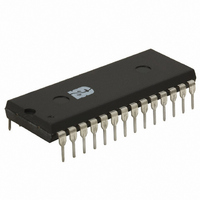ISD5116PY Nuvoton Technology Corporation of America, ISD5116PY Datasheet - Page 73

ISD5116PY
Manufacturer Part Number
ISD5116PY
Description
IC VOICE REC/PLAY 8-16MN 28-DIP
Manufacturer
Nuvoton Technology Corporation of America
Series
ISD5100r
Datasheet
1.ISD5116SY.pdf
(90 pages)
Specifications of ISD5116PY
Interface
I²C
Filter Pass Band
1.7 ~ 3.4kHz
Duration
8 ~ 16 Min
Mounting Type
Through Hole
Package / Case
28-DIP (0.600", 15.24mm)
For Use With
ISD-ES511 - EVALUATION SYSTEM FOR ISD5100ISD-ES501 - EVALUATION SYSTEM FOR ISD5008
Lead Free Status / RoHS Status
Lead free / RoHS Compliant
Available stocks
Company
Part Number
Manufacturer
Quantity
Price
Company:
Part Number:
ISD5116PY
Manufacturer:
Intersil
Quantity:
360
Since the I2C protocol allows multiple devices on the bus, each device must have an address. This
address is known as a “Slave Address”. A Slave Address consists of 7 bits, followed by a single bit
that indicates the direction of data flow. This single bit is 1 for a Write cycle, which indicates the data is
being sent from the current bus master to the device being addressed. This single bit is a 0 for a Read
cycle, which indicates that the data is being sent from the device being addressed to the current bus
master. For example, the valid Slave Addresses for the ISD5100 Series device, for both Write and
Read cycles, are shown in
Before any data is transmitted on the I2C interface, the current bus master must address the slave it
wishes to transfer data to or from. The Slave Address is always sent out as the 1
Start Condition sequence. An example of a Master transmitting an address to a ISD5100 Series slave
is shown below. In this case, the Master is writing data to the slave and the R/W bit is “0”, i.e. a Write
cycle. All the bits transferred are from the Master to the Slave, except for the indicated Acknowledge
bits. The following example details the transfer explained in
datasheet.
A common procedure in the ISD5100 Series is the reading of the Status Bytes. The Read Status
condition in the ISD5100 Series is triggered when the Master addresses the chip with its proper Slave
Address, immediately followed by the R/W bit set to a “1” and without the Command Byte being sent.
This is an example of the Master sending to the Slave, immediately followed by the Slave sending
data back to the Master. The “N” not-acknowledge cycle from the Master ends the transfer of data
from the Slave. The following example details the transfer explained in
datasheet.
Start Bit
S
9.5. I
SLAVE ADDRESS
2
C P
ROTOCOL
acknowledgement
R/W
from slave
W A
Master Transmits to Slave Receiver (Write) Mode
section 7.3.1
COMMAND BYTE
acknowledgement
on page 13 of this datasheet.
from slave
A
- 73 -
High ADDR. BYTE
acknowledgement
section 7.3.1-2-3
from slave
A
Publication Release Date: Oct 31, 2008
Low ADDR. BYTE
section 7.3.1
ISD5100 SERIES
acknowledgement
on pages 13-20 of this
from slave
st
A
on page 13 of this
Stop Bit
byte following the
P
Revision 1.42












